1. Key Theorists
1.1. Punya Mishra
1.2. Matthew Koehler
2. Technology Theories
2.1. SCOT
2.1.1. Key Ideas
2.1.1.1. Social Construction of Technology
2.1.1.2. Society & human action influence technology, not the other way around
2.1.1.2.1. Human action shapes technology
2.1.1.3. The analysis of whether or not a piece of technology was successful in society
2.1.1.3.1. Success or failure of technology is socially determined regardless of how effective the technology actually is
2.2. Media Ecology
2.2.1. Key Theorists
2.2.1.1. Marshall McLuhan
2.2.1.2. Neil Postman
2.2.2. Key Ideas
2.2.2.1. Technology influences society
2.2.2.2. The way we communicate determines what we communicate, which affects the rest of life & society
2.2.2.2.1. The medium is the message
2.2.2.3. Technology, modes of information, and media techniques play a leading role in human affairs
2.2.2.4. Media Ecology Association
3. Learning Theories
3.1. Behaviorism
3.1.1. Key Theorists
3.1.1.1. Ivan Pavlov
3.1.1.2. John Watson
3.1.1.3. Edward Thorndike
3.1.1.4. B. F. Skinner
3.1.2. Key Ideas
3.1.2.1. Stimulus-Response and Repetition
3.1.2.1.1. The brain is a blank slate, and we learn from environmental stimuli
3.1.2.2. Operant Conditioning and Reinforcement
3.1.2.3. Punishment and Consequences
3.1.2.4. Drill and Practice
3.1.2.4.1. "Practice makes perfect!"
3.1.2.4.2. Rote Learning
3.1.2.5. Lecture as the primary mode of learning
3.1.2.5.1. Teacher-Directed, and Direct Instruction
3.1.2.6. Cuing, Shaping, and Modelling
3.1.3. Criticisms
3.1.3.1. Oversimplifies the process of learning
3.1.3.2. Learning is not always tied to behavior
3.1.3.3. Learning should not require rewards or punishments
3.1.3.4. The mind is not a blank slate
3.1.3.4.1. People are capable of adaptation
3.2. Cognitivism
3.2.1. Cognitive Load Theory
3.2.1.1. Processing information can over or under load working memory, which makes it difficult to learn
3.2.1.2. 3 things affect the working memory's ability to learn
3.2.1.2.1. 1. Extraneous cognitive load - external distractions
3.2.1.2.2. 2. Intrinsic cognitive load - the difficulty of the learning task itself
3.2.1.2.3. 3. Germane cognitive load - overstimulation
3.2.2. Key Theorists
3.2.2.1. Jean Piaget
3.2.2.2. Robert Gagne
3.2.2.3. Lev Vygotsky
3.2.2.4. Jerome Bruner
3.2.3. Key Ideas
3.2.3.1. Memory systems are active, organized processors of information
3.2.3.1.1. The mind is not a "blank slate"
3.2.3.1.2. Prior knowledge is key in learning
3.2.3.1.3. "The mind is a computer."
3.2.3.2. schema/scaffolding
3.2.3.2.1. patterns of thinking which scaffold together and build constantly on what you already know
3.2.3.3. Atkinson-Shiffrin Memory Model
3.2.3.3.1. info is gathered using sensory memory, which is then stored in working memory and moved to long term memory if deemed important enough
3.2.3.4. meaningful effect
3.2.3.4.1. learning must relate to preexisting schema
3.2.3.5. Motivation must be intrinsic
3.2.3.6. Practice is used for retention and to build schema
3.2.3.7. Information must be organized in a way that makes sense to the learner
3.2.3.7.1. linear vs. non-linear
3.2.3.8. Information connection devices
3.2.3.8.1. metaphors and symbols
3.2.3.8.2. mental maps and advanced organizers
3.2.3.8.3. mneumonic and memory devices
3.2.4. Criticism
3.2.4.1. too focused on the attaining of knowledge, not on the use of skills
3.3. Connectivism
3.3.1. Key Theorists
3.3.1.1. George Siemens
3.3.1.2. Stephen Downes
3.3.2. Key Ideas
3.3.2.1. Learning is the process of creating connections and developing a network
3.3.2.2. Learning and knowledge rests in diversity of opinions
3.3.2.3. Learning is a process of connecting specialized nodes of information sources
3.3.2.3.1. Nurturing and maintaining connections is needed to facilitate continual learning
3.3.2.4. Capacity to know more is more critical than what is currently known
3.3.2.4.1. It is more important to "know where" to find things in your network than to "know how" or "know what."
3.3.3. Criticisms
3.3.3.1. Socialization should not be a goal of education
3.3.3.2. Learning becomes informal
3.4. Constructivism
3.4.1. Key Ideas
3.4.1.1. the mind is a rhizome/network
3.4.1.2. Learning is building connections by actively interacting with the environment
3.4.1.2.1. problem-based and project-based learning
3.4.1.2.2. authentic tasks
3.4.1.3. Begin with complex problems and teach basic skills while solving these problems
3.4.1.3.1. discovery learning
3.4.1.4. Learning involves constructing one's own knowledge from one's own experiences
3.4.1.5. Vygotsky's zone of proximal development
3.4.1.5.1. teach a little bit ahead of where your students are
3.4.2. Criticisms
3.4.2.1. time consuming
3.4.2.2. requires mature learners
3.4.2.3. difficult to assess
3.4.2.4. impractical without prior knowledge in the area
3.4.2.5. lacks supporting research and empirical evidence
4. Teaching Frameworks
4.1. TPACK
4.1.1. Key Ideas
4.1.1.1. Effective teaching using technology integration occurs amongst a relationship between 3 kinds of knowledge
4.1.1.2. 1. Technological Knowledge (TK)
4.1.1.2.1. Knowledge of different types of technology tools that can be integrated into teaching
4.1.1.2.2. How to use this technology effectively in teaching
4.1.1.2.3. Part of Technological Content Knowledge (TCK) and Technological Pedagogical Knowledge (TPK)
4.1.1.3. 2. Content Knowledge (CK)
4.1.1.3.1. Knowledge about a specific subject area
4.1.1.3.2. Ensures students have the skills and knowledge required to complete a task
4.1.1.3.3. Part of Technological Content Knowledge (TCK) and Pedagogical Content Knowledge (PCK)
4.1.1.4. 3. Pedagogical Knowledge (PK)
4.1.1.4.1. Knowledge about how to teach
4.1.1.4.2. Ensures tasks are suited to outcomes and learners
4.1.1.4.3. Part of Pedagogical Content Knowledge (PCK) and Technological Pedagogical Knowledge (TPK)
4.2. Philosophy of Teachnology
4.2.1. Key Ideas
4.2.1.1. A teacher's individual idea of how technology can be used in their teaching
4.2.1.2. Includes technology in the classroom, online learning, and Professional Development
4.2.1.3. Can include a PLN
4.2.1.4. Can be developed using written statements
